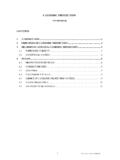Transcription of Soil resistivity as related to underground corrosion and ...
1 JOURNAL O F RESEARCH of the National Bureau of Standards-Co Engineering and Instrumentation Vol. 69C, No. I, January-March 1965 soil resistivity as related to underground corrosion and cathodic protection w. J. Schwerdtfeger (August 4, 1964) corrosion data disc ussed ill this pap er a r c base d upon m easure me nts made on about 4500 s pecime ns of commonl y used plain wroug h t ferrous mat ria l which had been buried in back-filled Lre nc hes at 86 National Bureau of Standards sites for p eriods up to 17 years. The soils ranged in resistivity from 50 to 54,000 !1-cm a nd in p H from to Maximum pit depths at 5 years of expos ure are take n from pit d epth-time curves and the curves arc also extrapolated t o probable pit d epths at 30 years for each of the 86 sites.
2 Furthermore, data Oil t he specime ns are adjust ed to m aximum pit d epths that might be e xpected on a lar ger area, equivalent to t hat of the exterior surface of a 20 ft length of 8 in . ullcoated wrought fe rrous pipe. Maximum penetration ratcs and pit depths arc presented with r es pect to soil res and pH. \Veight losses which rcsulted from about 2 years of unde rg round exposure a rc converted to corrosion current densit ies a lld after this period o f exposure current d e nsit ies arc calculated from the slopes of weight l oss-time curves for each site. On t h e basis o f ratios of protective current t o corrosion current obtaine d from polarization curves on steel s pecimen s u n der-ground and in soils in the laboratory, t he corrosion current densities can be adjusted to approximate current densit ies necessary for cathodic protection .
3 1 . Introduction Between the years 1922 and 1952 the Nationftl Bureau of Standftrds exposed tbousttnds of metallic specimens at numerous under ground sites through-out the United States. corrosion rates of O\Ter 300 vftrieties of protected and unprotected metals and alloys were evaluated about every 2 year s for exposw-e periods as long as 17 years. The accumu-lated corrosion data were compiled by Romanoff [IV The engineering significance of early NBS data pertaining to some commonly u sed wTought ferrous materials from the original 47 test sites WftS discussed in considerable detail by Logan [2]. The present paper is similar but includes data from about 40 additional sites and, based on the total available data, offers s uggestions 011 the current densit ies probably required for cathodic protection .]
4 In this paper, in addition to extrapolating the average maximum pit depths to 30 years as Logan [2] did, the weight losses of the specimens are con-verted to corrosion current densities. From these data the approximate current densities required for the cathodic protection of bare underground surfaces can be estimated. Although, based on NBS data, there is no precise relationship between the cor-ro si \Tity and resistivity of soils, a general relation-ship is now revealed by the total ftccumulated data. This is also indicated by the data of Scott [3]. Recently, Schaschl and .Marsh [4] discussed t he effect of resisti \rity on the corrosion rates of steel in aqueous environments and showed t hat for resistivities above 400 Q-cm, the corrosion rate bears an inverse relation to the resistivity of the electro-lyte.
5 Thus, a study is undertaken of the influence of soil resistivity , a meaSLll'ement readily made in the field. The combined relation of pH and soil resistiv-I Figures in brackets indicate the literature references at the end of this pa per. 71 ity to corrosion rate was also investigated. The m etftls to which our data apply are confined to open-hearth iron, h and-puddled and mechanically puddled wrought irons, open-hearth and Bessemer steels, all witho ut added alloying constituents. 2. Corrosiveness of Soils The corrosiveness of a soil might be defined as its d estructi \Te or deteriorating effect on a metallic surface, ftS mea ured by weight loss and pit depth. A soil Cftll be potentially cOl'l'osi \'e and yet have a n egligible effect on phin ferrous mftterials.
6 This was rece ntly s hown by Romanoff [5] as a res ult of his examination of steel pilings (pulled) exposed from 7 to 40 year s in a variety of soils some of which hadresisti \'ities as low as 300 Q-cm. No appreciable amount of corrosion was obselTed on pile surfaces adjacent to soils into which the piles had been dri\Ten below the water table, referred to as "undis-turbed" soil . This type of exposLll'e is in contrast to the soil exposure of metftls in back-filled trenches, referred to as "disturbed" soil . On driven piling, t he corrosion rate decreases rapidly as the initially. available oxygen is depleted by the corrosion process and the accessibility of more is limited. In dis-tm bed soils oxygen is more readily replenished and the soil is only very slowly restored to its natural state.
7 This gives rise to differential aeration and then the corrosiveness of the soil depends largely on its physicftl and chemical properties. Properties of the soils to be considered have already been described [1]. The most severe corrosion usually takes place at low elevations in poorly drained disturbed soils, such as clays and tidal marshes, where, although also poorly aerated, the differential-aeration effects are large because of soil shrinkage. Then too, salts accumulate in these areas and increase the conduc-tivity of soil . Th~ pH of such soils is usually neutral or I? the. alkalme range. In contrast, the least corrOSIve sOlIs are well aerated well drained an~ seem to be in areas of high annu~l precipitation ~hlCh causes the salts to be washed away and mcreases the so il resistivity .
8 The pH is usually between 4 and 7. 3. Effect of Area and Duration of Exposure The data u sed in this paper are mostly for accu-mulated exposure periods of 12 and 14 years. In some soils the accumulated periods are 7 and 17 years. The exposed area of each specimen was about ft2. It is of importance to know the effect of larcrer areas and longer periods of exposure. These v~ri a bIes have been considered by previous investigators [6,7]. Years ago, Scott [6] observed that pit depth is a function of the area of metal exposed. Based on National Bureau of Standards data and on data from pipelines, a linear relation was obtained when the logarithm of the average of the deepest pits (se,:"eral specimen~) on a given area was plotted agamst the logarIthm of the area for increasing areas.
9 Thus, for a modest extrapolation of the area Scott suggested the empirical equation, ' log P = a log A+log b, or P =bAu, (1) where P is the average maximum pit depth on the ~roposed area A, ~xponent a is the slope of the best Imear , and b IS the average maximum pit depth for a umt area. The useful form of this equation is, PZ/Pl = (A2/AI)a or PZ= PI (A2/A1)U, (2) where PI is the averag~ maximum pit depth on a known area AI, and P2 IS the extrapolated or calcu-lated average maximum pit depth on some assumed area Az for the length of exposure time. Scott sug-gested as a standard area that of the exterior of a 20 ft l ength of 8 in. diam pipe which is about ft 2 .. The for. the exponent, a, applicable to Spe?lmenS m 47. sOlIs have been given by Logan, Ewmg, and DenISon [7].
10 Based on their data the avera~e value. of a = has been suggested for u se ~th all ~oils, as the exponent is apparently not assocIated WIth any known soil property [81. The effect of length of exposure time on rates of corrosion underground is better known than is th e effect. of area exposed. For example, it is well known that III some soils, after a few years, corrosion seems to ?ease. The effect of duration of exposure on cor-rOSIOn rates depends on chemical and physical prop-ert~es of the s?ils. Here again , it was observed that a lmear relatIOn ~ppears to apply reason abl y well b~tween the logarIthm of the average of m aximum PIt. d~pths and the logarithm of the exposure period. ThIS IS expressed by the equation, l og P = n l og T + log k, or p =kTn, (3) ~here P is.]










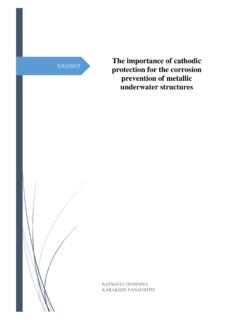

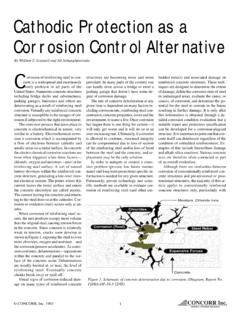
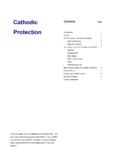
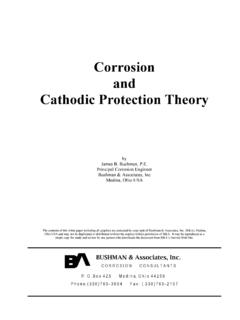



![Corrosion Protection.ppt [Read-Only] - University of Iowa](/cache/preview/1/c/f/9/2/e/d/5/thumb-1cf92ed5cf903dbf2b6cd3a840081a01.jpg)
